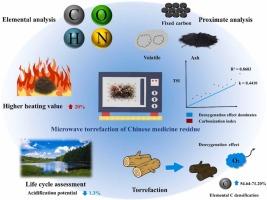Microwave torrefaction of biomass waste: Fuel property evaluation and life cycle impact
引用次数: 0
Abstract
The investigation of microwave torrefaction for solid biofuel production is significant for biomass waste conversion and environmental sustainability. In this study, a comprehensive analysis of microwave torrefied biochar fuel property and life cycle assessment is employed. The Chinese medicine residue is selected as the feedstock for biochar preparation, and its fuel property and environmental impact are evaluated. The obtained results suggest that with the increasing torrefaction severity, the fuel performance gradually becomes better. Concerning the proximate analysis, the values of volatile matter, fixed carbon, moisture, and ash content are 57.93–81.23%, 13.77–35.59%, 1.65–2.36%, 2.64–4.83%, respectively. A severer torrefaction condition would arise a better decarbonization and deoxygenation effect. Good linear relationships are obtained between torrefaction severity index (TSI) and carbonization index and TSI and deoxygenation index, with the correlation coefficient of 0.8683 and 0.8600. The life cycle assessment (LCA) result indicates that microwave torrefaction process would arise the environmental impact on greenhouse gas (GHG) emission, human toxicity, ionizing radiation, land use, and water environment pollution. Specifically, over 20% improvement in heating value and reduction in GHG emissions are achieved via microwave torrefaction process. However, lab-scale microwave torrefaction (10 g/batch) with gate-to-gate LCA shows 20% GHG reduction but excludes full-scale impacts. Totally, the obtained results are helpful for the cognition of fuel property variation and environmental impact of the Chinese medicine residue conversion and solid biofuel production, and thus for better waste-to-energy process to achieve biowastes valorization.

微波焙烧生物质废弃物:燃料特性评价和生命周期影响
微波焙烧用于固体生物燃料生产的研究对生物质废弃物转化和环境可持续性具有重要意义。本研究采用微波固化生物炭燃料性能综合分析和生命周期评价方法。选择中药渣作为制备生物炭的原料,对其燃料性能和环境影响进行了评价。研究结果表明,随着燃烧强度的增加,燃料性能逐渐变好。近似分析结果表明,土壤挥发物、固定碳、水分、灰分含量分别为57.93 ~ 81.23%、13.77 ~ 35.59%、1.65 ~ 2.36%、2.64 ~ 4.83%。较严格的焙烧条件会产生较好的脱碳和脱氧效果。焙烧严重程度指数(TSI)与炭化指数、TSI与脱氧指数呈良好的线性关系,相关系数分别为0.8683和0.8600。生命周期评价(LCA)结果表明,微波焙烧过程在温室气体排放、人体毒性、电离辐射、土地利用和水环境污染等方面会产生环境影响。具体而言,通过微波焙烧工艺,热值提高20%以上,温室气体排放量减少。然而,采用门到门LCA的实验室规模微波加热(10 g/批)显示温室气体减少20%,但不包括全面影响。综上所述,所得结果有助于认识中药废渣转化和固体生物燃料生产的燃料特性变化和环境影响,从而更好地实现废物转化能源,实现生物废物的增值。
本文章由计算机程序翻译,如有差异,请以英文原文为准。
求助全文
约1分钟内获得全文
求助全文

 求助内容:
求助内容: 应助结果提醒方式:
应助结果提醒方式:


